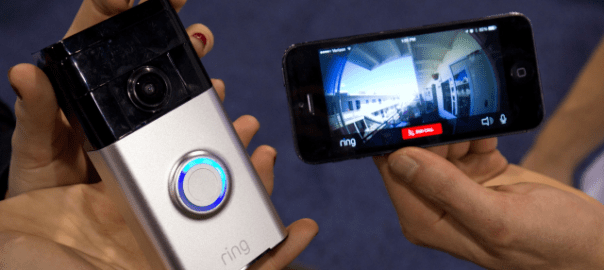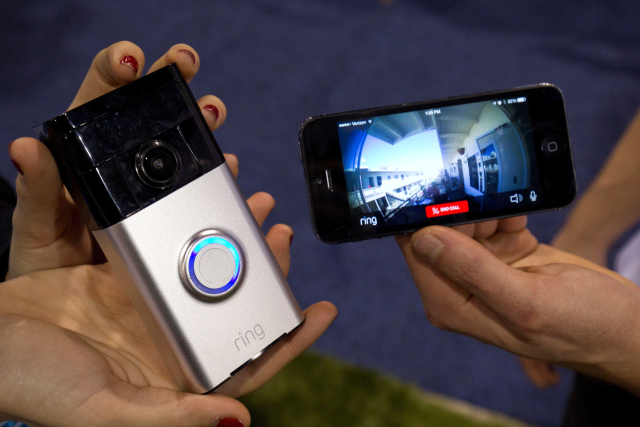By Samuel Woodhams | Digital rights researcher and journalist
| Video doorbells are everywhere now, sold as a modern security solution that can help protect your home and belongings. They let you greet guests remotely, deter would-be parcel thieves, and could even reduce the cost of your home insurance. Unfortunately, though, the increased security comes with hidden costs: a few weeks ago in Florida, a woman was shot at by a man and his son after an alert from their Amazon Ring app led them to think someone was trying to break into their home. It turned out that the person caught on camera was just dropping off a package that had mistakenly been delivered to their address. “Our victim was that close to death, and certainly, had there been a baby in the car seat, the baby would’ve been killed,” a local sheriff said in a news conference. Ring said it didn’t “condone vigilantism”.
A Ring video doorbell (L) is displayed during the 2015 International Consumer Electronics Show (CES) in Las Vegas, Nevada January 7, 2015. The doorbell connects with home Wi-Fi to send a video call to the homeowner’s smartphone. REUTERS/Steve Marcus |
Digital surveillance at the doorstep
Video doorbells record anyone who appears at a doorstep, sending an alert to the owner via an app so they can speak to them, and also lets people upload footage to social media and neighbourhood watch-style platforms like Amazon’s Neighbors. They are quickly becoming ubiquitous in parts of the United States, where there are an estimated 20 million devices. Amazon has about 40% share of the market, with Google’s Nest at about a fourth, and other makers including Vivint, Remo, August, SkyBell and SimplySafe also gaining ground. They are also gaining popularity in parts of Europe and Southeast Asia. In an ironic twist, even the current owners of George Orwell’s house in London have installed an Amazon Ring doorbell. With 13% of Americans reportedly having a parcel lost or stolen from their porch between May 2021 and April 2022, monitoring package deliveries is one of the most common reasons people say they buy video doorbells. But a recent report from Data & Society shows the cameras are having a negative impact on delivery drivers, and are becoming a “near-constant tool of workplace surveillance”, encouraging consumers to adopt behaviour typical of a manager. Video doorbells have also been criticised for threatening civil liberties and increasing racial profiling. For delivery drivers, the technology can make them more visible in hostile environments. “People out there are looking at me, because I’m a Black person in a high-class neighbourhood,” one interviewee told Data & Society. “They said that I should not be in their neighborhood.” It’s becoming increasingly clear that promises of increased security and convenience are leading people to unwittingly create a vast civilian surveillance system with potentially terrifying consequences. Last year, for example, the Los Angeles police requested footage from Amazon to monitor Black Lives Matter protesters. So what, if any, safeguards have been introduced?
An Amazon Ring sign is shown as a security warning at the entrance to a residential home in Encinitas, California, U.S., September 30, 2021. REUTERS/Mike Blake |
Data protection and the future of civilian surveillance
Earlier this year, the UK’s data protection agency outlined best practice for the use of home surveillance systems, including video doorbells. The agency said data protection laws do not apply if someone is only capturing data from their private property. But the devices’ sensitive microphones and wide-angle lenses can make this hard to achieve. In 2021, for example, a man was found to have breached data protection laws because his camera system was collecting images and audio of his neighbours. In Singapore, there are restrictions on the use of CCTV and video doorbells in public housing if they overlook common areas, but these are less stringent in private housing and properties with land. And in the United States, various organisations have called on Amazon to stop sharing data with the police. Following the case in Florida, the New York-based Surveillance Technology Oversight Project (STOP) has called on Amazon to stop selling their Ring products entirely. As the unintended consequences of the technology become increasingly evident, further restrictions on their use may materialise. But even if they do, the broader issues of employee monitoring and the racial inequities caused by surveillance technology won’t be resolved. As surveillance of workers rises rapidly due to the expansion of algorithmic management tools and a reduction in the price of advanced surveillance technology, video doorbells are just one of a range of technologies that impact gig workers’ rights and privacy of others, with dashcams and cameras on autonomous vehicles also raising these concerns. From facial recognition cameras in vehicles to GPS monitoring devices installed on mobiles, surveillance technology is increasingly being used to monitor people working in already precarious conditions. With Black Friday sales later this month, the prices of many popular video doorbells are likely to drop considerably. But while the increase in convenience and security is tempting, it’s worth remembering the hidden costs.
|



